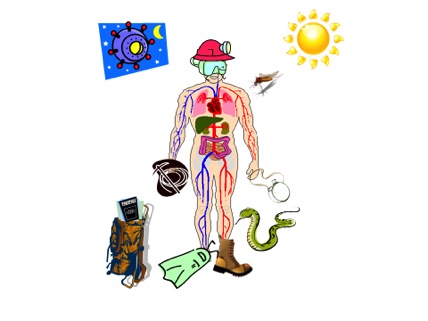Welcome to Base Camp Rx, a new column focusing on drug topics in wilderness medicine. In this introductory column, first we'll see if you know you and your patients' rights – at least, those related to medication administration - then we'll review the major types of drugs that are needed on a wilderness outing. Future columns will cover hot topics about drugs used (not "drug use!") in the wilderness.
Rights of Medication Administration
The number of Rights of Medication Administration varies depending on where you look: 5, 6, 7, 8…but we'll focus on the following seven for the wilderness setting. These were covered nicely in a short video by WMS member Michael Crawford.
Be sure to have the:
Right Patient: The medication belongs to the correct person.
Right Time: The medication is dosed correctly according to the appropriate schedule.
Right Medication: The medication is for the correct person and correct for the condition.
Right Dosage: The medication is the correct dosage for the person and for the condition.
Right Route: The medication is being administered via the correct route: oral, sublingual, topical, parenteral, etc.
Right Expiration Date: This appears on the original manufacturer's package or the pharmacy bottle label.
Right Documentation/Authorization: Try to mitigate risks to the person by not giving them a medication that might cause them harm, and mitigate risks to yourself, especially if you do not have the legal authorization to administer medication. If you do have a medical license, make sure you are not liable for harm; the concept of liability for harm is quite complicated and will be discussed in more detail in a future column.
One more R that could be added is Right Response: make sure the drug you gave resulted in the desired pharmacologic effect, especially if given for an acute situation.
Know Your Drugs
- Make sure you are fully informed about the drugs you are carrying and administering (if allowed). Read up about the drug in the PDR (Physicians Desk Reference, a compilation of manufacturer's prescribing information or a reliable drug information reference) and be familiar with indications, contraindications/warnings/precautions, adverse reactions, dosage, drug interactions, and use in different populations, such as children, elderly people, and pregnancy.
- Be familiar with brand (trade) and generic names. A drug may be the generic version but is still referred to by the brand name (e.g., Cipro).
- When traveling in the wilderness, be familiar with proper storage of the drugs you are taking, especially in different environmental settings (see "Medication Transport in the Wilderness" by Tatiana Havryliuk and Tracy Cushing).
- Over-the-counter (OTC) products: Remember, you need to follow the "Rs" for over-the-counter drugs as well. Just because they don't require a prescription doesn't mean that some of the same risks don't exist as for prescription drugs medications.
Know Your Patient
- Know your patients' medical history if you will be administering a drug to them, especially if they have a concomitant condition such as diabetes, heart disease, renal dysfunction, etc. Someone who has had acute blood loss and is in shock from trauma may handle a drug differently.
Medications for Wilderness Environments: It's Elemental
When you think about what medications should be taken on a wilderness trip, first break it down into the elements, then think of the areas of wilderness medicine settings for each of the elements, then identify the predominant types of risks, illness, or injuries that occur in those settings (note that many can occur in multiple settings).

*"bites" include insect bites and stings envenomations from snakes, arthropods, etc. and marine animals, animal bites (including humans on occasion!)

Drugs For Every System: Start with the Letter A
Medications for the body systems that are needed in wilderness medicine can be loosely grouped with terms starting with "A." This list is not exclusive and is only a guide!

Drugs for ACUTE situations. Think primarily about:
Emergencies: accident, medical, crime
Trauma: major to minor
Aches (trauma, pain): Antiinflammatories, Analgesics
Air (respiratory emergencies): Adrenergics, Epinephrine
Artery (CV emergencies-MI,stroke): Aspirin, Nitroglycerin
Infections: Antibiotics
Drugs for CHRONIC use. These are examples of medications that if not taken, the medical condition being treated could turn acute:
Affect: Anxiolytics, Antipsychotics, Antidepressants
Air: Asthma meds
Artery: Heart failure, hypertension meds
Diabetes: Insulin, Oral antidiabetics
Seizures: Anticonvulsants
Hot Topics on Drugs in the Wilderness
Drugs are always a hot topic, and this is no exception in wilderness medicine. Here are some issues that will be discussed in future columns. Stay tuned and start packing your medical kits!
- Epinephrine in wilderness settings
- Management of acute pain in remote environments
- Use of "performance enhancing" drugs at high altitude
- Liability with the use of expedition medical kits
Suggested Reading: Tonna JE, Lewin MR. Wilderness Preparation, Equipment, and Medical Supplies. In: Auerbach PS, ed. Wilderness Medicine. 6th ed. Philadelphia, PA: Elsevier Mosby; 2012:1820-1844.
Posted January 11, 2015